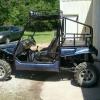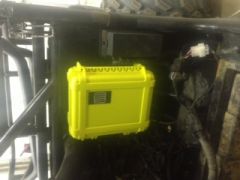-
Posts
358 -
Joined
-
Last visited
-
Days Won
6
Content Type
Profiles
Events
Forums
Gallery
Downloads
Community Map
Everything posted by bigdan120
-
Lol They should add it. I use it just to loosen up dirt and rust on alot of things.
-
To get that dang circlip loosened up.
-
The long-term active ingredient is a non-volatile, viscous oil which remains on the surface, providing lubrication and protection from moisture.[5] This is diluted with a volatile hydrocarbon to give a low viscosity fluid which can be sprayed and thus penetrate crevices. The volatile hydrocarbon then evaporates, leaving the oil behind. A propellant (originally a low-molecular weight hydrocarbon, now carbon dioxide) provides gas pressure in the can to force the liquid through the spray nozzle, then evaporates away. These properties make the product useful in both home and commercial fields; lubricating and loosening joints and hinges, removing dirt and residue, and extricating stuck screws and bolts are common usages. The product also may be useful in displacing moisture, as this is its original purpose and design intent. Due to its lightness (i.e., low viscosity), WD-40 is not always the preferred oil for certain applications. Applications that require higher viscosity oils may use motor oils, while those requiring a mid-range oil could use honing oil.[6]. Just sayin.
-
Ok wd40 it. Then get a buddy to help. Use a pry bar 3' is what I used on my rear placed in where you can then straight across from it use the punch bar and big hammer. Wood dont work we'll cause it gives to much. But saves on damage. That's why I use brass bar.
-
I used a brass 11/2" x 14 round bar. I put it on the back side off the inner cv the best I could on say a 45 degree through front frame and I beat it with a 3 lb hammer. Works pretty good. I use this method a good bit.
-
There is prob a short in the wiring. This problem has been discussed on here. Most just take and rewire it on there own with a relay. There is alot of great info on here just have to look around some.
-
First off Hello! Mine did the same thing...You cannot rebuild them there welded togather...Keep looking on here...If you are in a hurry you might just have to buy a new one..There are a few on here that put shocks on theirs....So you might get lucky...
-

Parts, Pieces, and Information for our Troopers & Joyners
bigdan120 replied to Kinarfi's topic in Joyner UTV SxS Forum
OK for the 09 Trooper T2 front CV's Outer Front NAPA 686-2149 Inner Front NAPA 686-2151- 42 replies
-
- 2
-

-
- trooper parts
- trooper
-
(and 1 more)
Tagged with:
-
Looking for some clarifacation please.. I need Cv Boots soon...One front outside ripped. Can you tell me which one to use? I have read the post and now I am just lost...I thought inside and outside boots were all the same? If not which ones do I need? I seen the post above for Geo Metros but which tranny Auto or Manual? I shop at Napa so there numbers will work....Thanks! Signed , Confused
-
From the album: Trooper T2
Water proof case I picked up and installed... -
Yeah wouldnt be cheap but how many would want it? I think it would be worth 150.00 for each.. Im would buy it for that providing I was working again.. What do you think?
-
Question. Does anyone know of we can have a new pinion made with say 2 less teeth and still make it match up? We could prob have a spacer made for behind the ring gear.
-

Renegade and trooper front diff difference
bigdan120 replied to nocturnalsixer's topic in Joyner UTV SxS Forum
Thats good to know for sure...I want to do that to mine someday..... -
Thanks Guys! This is why I own a Joyner...Everyone helps out!
-
The spider gear cross shaft...The one that is smooth except the cut out in the middle were they mate.. Thanks..... I edited my first post description I used wrong part name...
-
Well I bit the bullet and I am having a machine shop do it for me...120 to 150.00.. I can tell you it tested at Rockwell 51 If that helps anyone that cant test it but can make it...I can't tell but for some reason...Probably my ERROR when we took the carrier apart the S-3 Shim was ate up and inside with the spiders... I think it might have been the cause...I don't know Just GUESSING at it.. Theres no marks on the gears so who knows???? So I need a S-3 shim too LOL....Oh well I will make do with what I have.... P.S. Being LAID off Sucks! Thanks Guys!
-
Thanks for looking..... I have a machine shop that will make me one...They want 120.00 to make it... Ouch!!!!!!!!!!!!!!! I only need the one WITHOUT the groove in the end....
-
Hey guys looking for the SPIDER gear Shafts Sorry I put wrong part descrition in here first time... .....Anyone have a used one? Also I would like to get 1 more shim kit if anyone has one they will part with...Need shaft SOON.....Mine broke in half and was eating the case up.So if anyone that reads this and has a knock in the rear stop riding and pull it! 724 420 7079 Dan
-

Head Light Bulbs, Has any one found replacements
bigdan120 replied to Kinarfi's topic in Joyner UTV SxS Forum
Replacement Headlights I used are Sylvania H5006 High/Low. I would imaging the number is the same for any manufacturer. The Headlight sockets to change it over are Dorman 9003 High Temps..... -
Ok that allen screw I mentioned above is just a plugged oil port. No valving in there. Adjusted my idle up to 1000 to keep the pressure up for now. Going to get rebuilt over the winter.
-
Guess I might change oil to a heavier weight after I check it out more.
-
Right now the Chinese gauge says 75lb.
-
Well it's a lot like a few motors out there. Lol! There's simularities of a ford but I think it's still pretty much Chery. With what I have heard. Mine will flicker the oil light when idling hot also. I'm gonna check it out more next week. Hopefully I get a job soon so I can just pull the motor and go through it.
-
Ok I will start by saying I found my cat was plugged....Ok! that was fixed Cough Cough! Ran much better now...Ok now for the 2nd O2. Started looking at ways to fool the sensor..Did some research on it and found a couple ways..I don't know what is right or wrong..I'm a try it and see kinda guy sometimes... So if you buy a spark plug non fouler dorman 42009 at advance.( Same Thread as O2) Take it drill it out to 1/2 on the inside of it then install in the rear. Suppose to take it out of the stream enough that it just reads enough to work...I don't know if it works or not for sure. I can say that when I did that that it idled ruff and was acting all weird like it had a bad throttle position sensor... So I was messing around with it tonight and seen my fuel pressure was looking high..Like 65psi....Took and adjusted it down and it started running worse...Go figure! So I said heck with it and started turning it up and wala the miss went away. Now did the miss go away it is unreal the crispness of the throttle! Rediculously better! I mean WOW! Woke it up!!!! Can't wait to run it on the hills! So who knows but I do know this is the best by far that it has ran since I got it! Chime in! I just wished I had a way to compare it to another one! Ok well Going away over the weekend but I will be checking for updates! Have a Great Memorial day! Oh yeah check out Templeton Pa of Youtube....I gotta go there...Someone here is from there but it escapes me at this moment of who...LOL Sorry....
-
Hey can someone let me know what oil pressure there Trooper idles at when hot? Prefer wet line gauge answers..... Mine is at 50 or more hot then down to 12lb hot.... I did alittle research and came up with worn bearings...800 Miles? I guess it could be... I also looked at the ford forums found there might be a pressure relief valve to mess with to adjust some...I believe I found the plug for it but no research yet on it....






